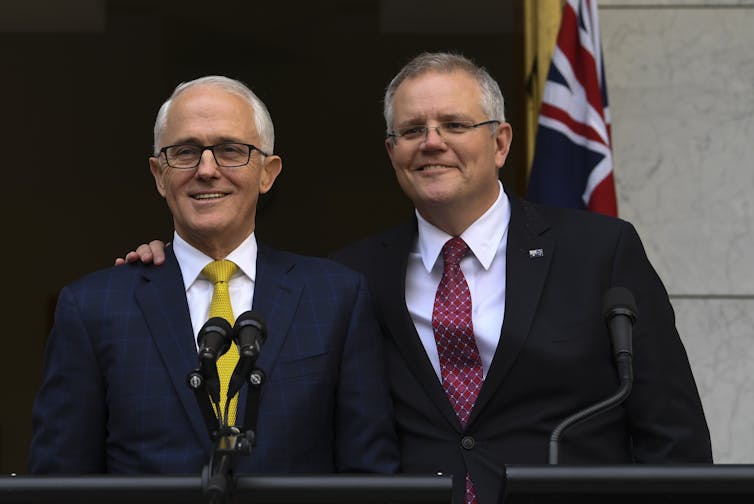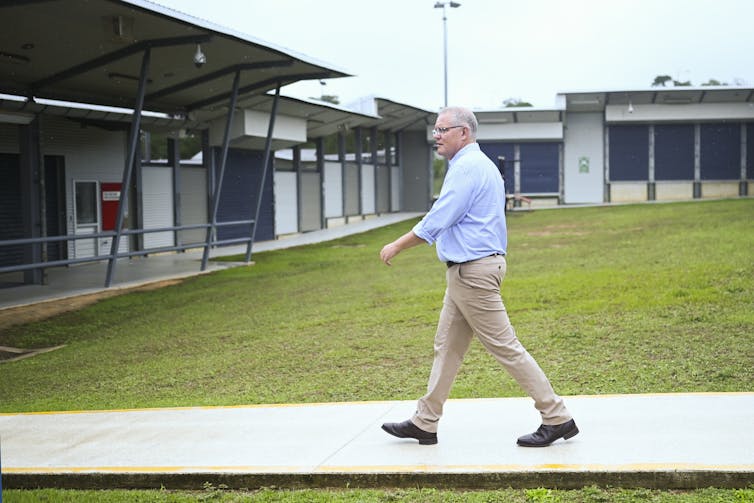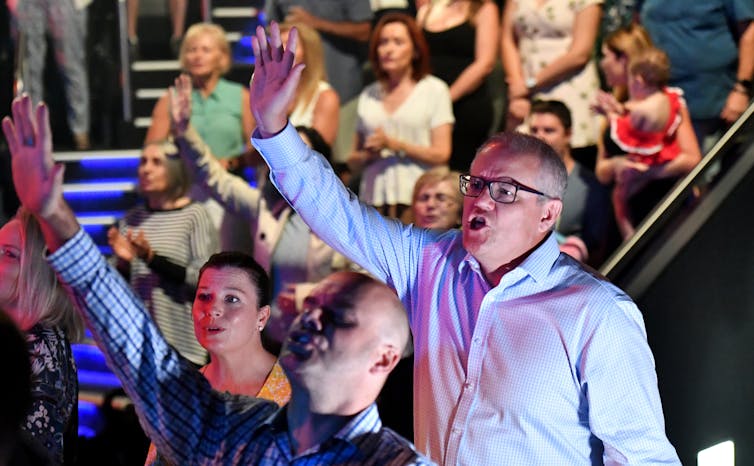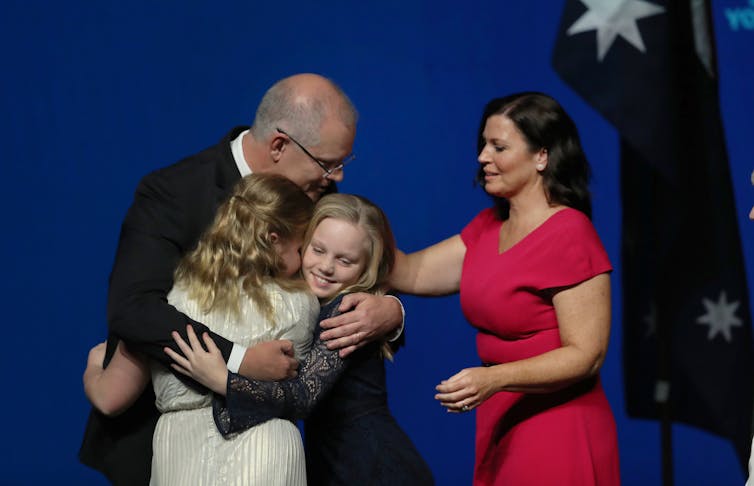Against the odds, Scott Morrison wants to be returned as prime minister. But who the bloody hell is he?
- Written by Michelle Grattan, Professorial Fellow, University of Canberra
Today we run two longer reads on the men who are vying to become prime minister at the 2019 federal election. In this piece, Michelle Grattan examines Scott Morrison’s political history and his prime ministership. You can read Professor Paul Strangio’s essay on Bill Shorten here.
Jim Molan, the former major-general who was the co-author with Scott Morrison of the Coalition’s Operation Sovereign Borders, remembers vividly Morrison’s mood immediately after the 2013 victory.
The election was on September 7, but the new government wasn’t sworn in until September 18. “He was frustrated because he was so ready to start his job, but he couldn’t start it on Day One,” Molan says.
So it was predictable that when Morrison seized the leadership after the fall of Malcolm Turnbull last August, he was on the road almost immediately, visiting drought-stricken Queensland. And it was unsurprising that Morrison soon started to come through the Labor research as a PM “getting on with the job”.
Colleagues and commentators looking at Morrison default to “action” and “ambition”. For some, those descriptions are positives; for others, negatives.
It’s possible to over-think Morrison. Long time political associate and friend David Gazard is probably right when he says “what you see is what you get”.
As he fights against the odds in this election, we see in Morrison a leader who’s tough, pragmatic, indefatigable. He’s simultaneously authentic (more people can relate to him than could to Malcolm Turnbull) and a chameleon (it’s hard to know what the beliefs are that they’re relating to, because he adapts to the circumstances he finds himself in).
Gazard attests to Morrison’s prodigious capacity for work. When Gazard was chief-of-staff to NSW opposition leader John Brogden, he would call Morrison, who was Liberal state director, at the end of the day for his help with speeches.
He’d show up at 7.30 pm for a couple of hours. If you went to the bathroom and came back, he’d be sitting in your chair, writing.
If you had to describe Morrison in a single word, perhaps you’d call him a “journeyman” of politics, in the dictionary definition a player who’s “reliable but not outstanding”. He’s not cerebral but he’s clever and cunning; he’s competent, but not charismatic nor inspiring.
His combative style was evident during the second debate when he advanced on Bill Shorten, who quipped he was a “space invader”. But comparisons with Mark Latham’s notorious handshake with John Howard late in the 2004 campaign were false.
Morrison had long been steadily climbing towards the leadership, though it seemed more likely this would come after a government defeat. There is debate about whether or to what degree he intrigued in the August 2018 coup against Malcolm Turnbull. But his capacity to don a mask was evident on Wednesday August 22, two days before Turnbull’s fall when, asked at a news conference to rule out having any leadership ambitions, he put a comradely arm around Turnbull’s shoulder and said “Me, this is my leader and I’m ambitious for him!”
 Morrison with Turnbull in August 2018: ‘This is my leader and I’m ambitious for him!’
AAP/Lukas Coch
Morrison with Turnbull in August 2018: ‘This is my leader and I’m ambitious for him!’
AAP/Lukas Coch
One Liberal observer declares: “I’m very sure he was very much aware of what was going on – others on his behalf were active”. Pamela Williams, writing in The Monthly, reported that, by the Wednesday, Morrison was simultaneously standing by Turnbull and giving “the green light for his own tight group to start counting numbers”, so he could move in the event of Turnbull’s collapse.
Whatever the ins and outs, Morrison obtained the prime ministership in circumstances in which he was likely soon to lose it.
Initially, the opinion polls plunged, and he was dogged by the question “why isn’t Malcolm Turnbull prime minister?”. It’s a question that never entirely disappeared. But Morrison’s performance was better than many expected and the polls narrowed back to where Turnbull had them.
His opponents are wrong in trying to dismiss him as simply the one-time advertising man turned political showman, but certainly Morrison (who as a kid did some acting and appeared in a few TV advertisements) knows the value of creating a “set”, whether visual or atmospheric, and galvanising attention.
After becoming leader, he took his road show to Albury, scene of one of the Liberal party’s founding conferences in 1944, and invoked the spirit of Robert Menzies. The backdrop appealed to the loyalists. “I like rituals,” he told his audience.
His standout example of conjuring up a “moment” was the Great Strawberry Crisis. Needles had been put into some strawberries; from the start, it was believed the culprit was a disgruntled employee, which turned out to be the case, but there was concern about “copycat” activity. All a problem, of course, though hardly needing federal parliament to leap into action.
Morrison announced legislation with draconian penalties – despite the strong existing regime and the fact this was mainly a state matter. Parliament rushed the bill through.
Read more: What will the Turnbull-Morrison government be remembered for?
Morrison had elevated a limited issue requiring only the enforcement of the existing law into a mega story. Politically, the importance of the incident was it showed the new PM acting decisively.
Another, more dramatic example of Morrison’s use of “framing” was his taking the media to Christmas Island to mark the detention centre’s re-opening, after the passage of the medevac legislation to facilitate medical transfers. In the event, the wave of transfers the government had warned of didn’t materialise.
 In the wake of the medevac bill passing, Morrison took the media on an expensive trip to Christmas Island.
AAP/Lukas Coch
In the wake of the medevac bill passing, Morrison took the media on an expensive trip to Christmas Island.
AAP/Lukas Coch
As a former party official, Morrison is steeped in the dark arts of the political tactician as well as, from his advertising days, the techniques of marketing. He’s master of the sharp slogan, the quick denial (never mind whether accurate or not), the abrupt walk off when a news conference threatens to become awkward. He has the knack of smothering a line of questioning.
If someone asked the “real Scott Morrison to please stand up”, two men might rise to their feet. The uncompromising, don’t-give-an-inch Scott, and a more conciliatory, flexible character.
As immigration minister cracking down on the borders, he closed off information, selectively leaked stories that were later discredited, seemed untroubled by human rights issues. He had taken a different line in opposition when it had suited him, for example expressing concern about the welfare of people who might be dispatched under Labor’s proposed “Malaysia solution”.
When he moved to social services, he emerged as a negotiator, with the welfare lobby and the Senate. Cassandra Goldie, CEO of Australian Council of Social Service, recalls Morrison from that time as “adaptable, pragmatic and able to spot a political opportunity. He showed he was capable of changing direction to build support.” Another source puts it more harshly: “He’s a shape-shifter. He pivots for the opportunity, and his gospel is the gospel of politics”.
His period as treasurer – a post to which Turnbull appointed him after Tony Abbott was deposed – revealed much about him as an operator.
His part in that coup had been typical Morrison. He’d voted for Abbott but some of his small group of followers had (it was presumed with his support) put their backing behind Turnbull. Abbott was incandescent. Shock-jock Ray Hadley excoriated Morrison in an excruciating interview in which he demanded Morrison swear his innocence on a bible.
Morrison was determined to make his mark in Treasury. Turnbull and Morrison considered an ambitious reform of the GST, with the aim of enabling big income tax cuts. Morrison ran the issue hard in the media. Turnbull became alarmed he was getting too far out in front. Treasury work showed the plan (in any politically acceptable form) didn’t stack up and, to Morrison’s embarrassment, he was reined by his boss.
One source – a critic of Morrison – who observed the internal debate says he “didn’t seem to care” about the Treasury work. “For him, [GST reform] was a political flag. I don’t know if I’ve ever seen a more purely political operator.”
Morrison had “a propensity to grab a stick and then run off with it”, according to a bureaucrat. His more cautious ministerial partner, Mathias Cormann in finance, “talked him off the ledge” on various occasions.
A Liberal backbencher recalls Morrison, in those days, using his authority to lean on people.
When he runs out of intellectual runway, he’ll just say, I’m asking for your support on this one and I think I deserve it.
Gazard, an admirer, says Morrison “comes to a view by consulting a whole range of people”. But “when he comes to a view he can be hard to move – he won’t give up on that conviction easily”. Morrison paints this as a virtue, saying at his campaign launch, “When I get determined, I get very determined”.
In the election campaign, Morrison hasn’t been sharing the limelight with his team, in contrast to Shorten, who has sought to neutralise his unpopularity by surrounding himself with strong colleagues.
At his campaign launch, Shorten had his bevy of frontbenchers on stage and three former PMs in the audience. The “team” was a theme.
Morrison said repeatedly ahead of his formal launch on Sunday that it would be “different”.
It’s not about the Liberal Party and it’s not about the National Party.[…] I just want to have a conversation with people on Sunday directly about the choice.
Given the thinness of his ranks, with multiple high profile Coalition figures leaving at the election, it would have been hard for Morrison to accentuate the team. And the coups meant the past two PMs couldn’t or wouldn’t be there – and that made it impossible to have party icon John Howard.
So the event, coinciding by chance or design with Mother’s Day, was a plain, homespun affair, with all the Morrison family who could be mustered, a video of Scott and Jen talking about each other, and (appropriately) a promise to help aspiring young homeowners to bridge the deposit gap – that got blown away within a couple of hours by Labor matching it.
As one Liberal remarked of the launch: “It was the best we could do in the circumstances.”
Despite the obvious drawbacks, shouldering all the weight of the campaign, being ultra “presidential” (even if that term seems ridiculously overblown for him) suits Morrison’s temperament. He’s a natural one-man-band, filling the stage, pounding at the drums.
The bones of the Morrison story are well known. He was brought up in a middle-class home in the Sydney suburb of Bronte, son of a senior policeman who was community-minded and active in local government (as an independent), including becoming mayor of Waverley). Morrison as PM understands the importance of the “local” in politics.
The most notable parts of his pre-parliamentary career were his stints in tourism, in New Zealand and Australia, both of which ended badly, and, in between, his time as a Liberal official.
He was in the NSW Liberal post when Malcolm Turnbull ousted sitting member Peter King in the 2004 bitter Wentworth preselection, which involved a great deal of branch-stacking. Some sources will tell you Morrison favoured Turnbull, while others think he wanted King to hang on.
One view is that, as state director, Morrison practised “pan-factionalism” in the deeply-riven NSW party.
Liberals used to joke about Morrison’s penchant for walking both sides of the street after he attended the private gatherings of both right and left factions at a Liberal function.
Morrison entered parliament for the seat of Cook in the Sutherland Shire in 2007, after a highly controversial pre-selection. Although he’d come from another part of Sydney, he has adopted “The Shire” and everything about it, especially the Sharks rugby league team, as though his family were original settlers.
His prime ministerial persona plays up the footy-loving, suburban, family-oriented, curry-cooking dad. It works with some voters but others are cynical.
Focus group research in Wentworth last week, done for The Conversation, highlighted the conflicting views about Morrison. Some saw him as “basically decent”, “genuine”, “well-meaning”, “approachable”, a “family man”, someone who could “relate to an ordinary guy in the street”.
But on the negative side, older voters viewed him as a “Sharks-supporting salesman”, “a typical bogan”, “a typical politician”, a “bully”, while younger voters described him as “the local butcher, not the PM”, “a privileged white guy”, “insipid, religious, racist”, “sly”, an “arrogant hypocrite”.
 Morrison allowed the media into an Easter service at his Horizon church.
AAP/Mick Tsikas
Morrison allowed the media into an Easter service at his Horizon church.
AAP/Mick Tsikas
Perhaps the one thing that’s not “mainstream” about Morrison is his deep Pentecostal religious commitment. On all the evidence, he is very literalist in his religious convictions. Politically, it might have seemed a gamble to let the media into an Easter service of his Horizon church, but Morrison chose to be expansive about his faith. It was certainly an arresting sight to see the PM standing, arm raised, in full voice, praising the Lord.
Writing about Morrison’s Pentecostalism, James Boyce says his “idea of what it means to be PM is influenced by his experience of what it means to be a pastor – his constant positivity, enthusiastic hand gestures, fondness for a parliamentary clap and cheer, and wealth-enhancing ethics come straight from Horizon Church”.
Morrison says his religion is quite separate from his politics. He told parliament in his maiden speech:
My personal faith in Jesus Christ is not a political agenda.
But it influences his views, for example his opposition to same-sex marriage, and last year he told Sky he had concerns about the “trajectory” in relation to freedom of speech and religious freedom. The latter remains unfinished business for the Coalition.
Politically, Morrison’s strength is in the economic sphere. He’s been hardly tested on foreign affairs, although he did the “summit season” soon after becoming leader last year. His big foray, in a pitch for the Wentworth byelection, was to consider moving Australia’s embassy from Tel Aviv to Jerusalem; after much reaction, including from Indonesia, the government announced a compromise position.
Like Turnbull before him, Morrison launched his election campaign from the platform of a budget. Turnbull promised company tax cuts, only some of which he could eventually deliver. Morrison is running on income tax cuts, with a lot of the program way into the future.
Economic management is historically the Coalition’s strong campaigning ground, and economic credibility is a strength for Morrison in focus groups. But, weighed down by the government’s record of division, with minimal pledges for the future beyond the tax cuts, infrastructure and being a safe pair of hands, Morrison has little beyond his own energy and a scare campaign against Labor to carry through until polling day.
 Morrison embraces his family at the Liberal Party campaign launch.
AAP/David Crosling
Morrison embraces his family at the Liberal Party campaign launch.
AAP/David Crosling
And what then? If Morrison loses but respectably, it’s most likely he’d be opposition leader. Peter Dutton has indicated he would not challenge him for the job (anyway, it is an open question whether Dutton will be returned).
In what on the polls is the more unlikely event of a Coalition win, there aren’t many pointers to how a Morrison government would handle the next term.
Morrison would have immense authority, having done the apparently impossible. On the other hand, a re-elected Coalition would likely have a very small majority or be in minority government, which would impose constraints and probably see the Liberal party, beyond the initial elation of survival, as fractured as before.
Morrison says he would lead “from the middle”. Asked on the ABC who’d have the upper hand in driving Liberal party policy if he were re-elected, the right of the party or its mainstream, Morrison said, quickly and firmly, “I will”.
That fits with his personality, but leaves a heap of questions.
Authors: Michelle Grattan, Professorial Fellow, University of Canberra



